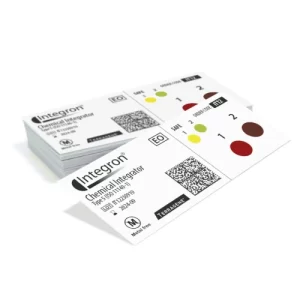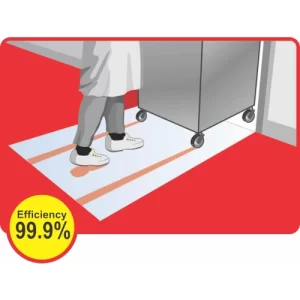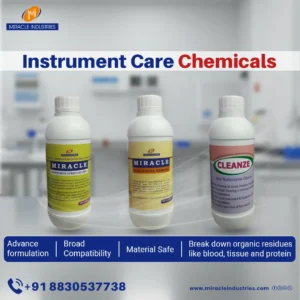Imagine trusting a sterilised instrument—only to find out it wasn’t truly safe. Shocking, right? In the world of healthcare, manufacturing, and laboratories, even the slightest compromise in sterilisation can lead to dangerous outcomes. That’s why chemical indicators for sterilisation play a vital role: they give you clear, immediate proof that your sterilisation process achieved the conditions needed to protect lives and quality.
In this blog, we will explore deep into what chemical indicators are, why they are essential, how they work, and how to choose the right one for your needs.
What Are Chemical Indicators for Sterilisation?
Chemical indicators are tools used to verify that sterilisation processes have reached the necessary conditions, such as the right temperature, pressure, and exposure time, to eliminate harmful microorganisms.
They typically change colour or form when exposed to the correct sterilisation parameters, providing a visual confirmation that instruments, tools, or equipment are ready for safe use.
Why Are Chemical Indicators So Important?
Sterilisation isn’t just about “running a machine.” It’s about ensuring absolute safety and trust. A steriliser can malfunction. Human error can happen. Chemical indicators act as a critical checkpoint—a second set of eyes—confirming that every cycle meets the required standards.

Without chemical indicators:
- You risk using improperly sterilised instruments.
- You could expose patients or products to dangerous contamination.
- You lose traceability for audits and quality control.
In short, chemical indicators are non-negotiable for anyone who values safety, compliance, and peace of mind.
How Do Chemical Indicators Work?
Chemical indicators are designed to react to specific sterilisation conditions. Each indicator contains sensitive chemicals that undergo a physical or chemical change, such as a colour shift, when the right combination of time, temperature, or presence of sterilant (like steam, ethylene oxide, or hydrogen peroxide) is achieved.
Different types of chemical indicators are matched with different types of sterilisation processes:
- Steam Sterilisation: Indicators react to high heat and moisture.
- Ethylene Oxide Sterilisation: Indicators respond to gas exposure and humidity.
- Plasma Sterilisation: Indicators react to hydrogen peroxide vapour and plasma conditions.
If the chemical indicator doesn’t change correctly, it’s an immediate warning sign that something went wrong during the sterilisation cycle.
Where Are Chemical Indicators Used?
Chemical indicators are used across industries where sterile environments are mandatory, such as:
- Hospitals and Clinics: Sterilising surgical instruments, trays, and supplies.
- Pharmaceutical Manufacturing: Ensuring cleanroom sterility.
- Dental Practices: Verifying sterilisation of tools and materials.
- Laboratories: Protecting research environments and specimen integrity.
- Food Processing: In speciality applications like aseptic packaging.
Choosing the Right Chemical Indicator
Choosing the right chemical indicator is essential for maintaining compliance and ensuring safety. Here’s how to select one:
- Match with Sterilisation Method: Steam, plasma, EO gas, or dry heat? Different indicators are designed for different methods.
- Understand Regulatory Requirements: Follow ISO 11140-1 standards and local regulations.
- Consider Your Load Complexity: Complex loads may require multi-variable indicators.
- Training and Ease of Interpretation: Pick indicators that your team can easily read and interpret without confusion.
Remember: The cost of using poor-quality indicators is far greater than the price of reliable ones.
Best Practices for Using Chemical Indicators
- Always place indicators both inside and outside of instrument packs.
- Document indicator results as part of your sterilisation log.
- Regularly train staff to interpret indicator results correctly.
- Replace expired indicators, as they lose reliability over time.
- If an indicator fails, immediately investigate the sterilisation cycle and do not use the load.
Conclusion
Chemical indicators for sterilisation are your first and most reliable defence against incomplete sterilisation. They are easy to use, cost-effective, and critical for patient and product safety. Whether you run a hospital steriliser or a pharmaceutical cleanroom, never skip this vital step.
Trust your instruments. Trust your process. Trust your indicators.
Because when it comes to sterilisation, there are no second chances.
Frequently Asked Questions (FAQS)
1: What is the difference between chemical indicators and biological indicators?
Chemical indicators visually confirm if sterilisation parameters were met during the cycle. Biological indicators, however, use live spores to test if the sterilisation process can kill microorganisms. Both are crucial but serve different purposes.
2: Can chemical indicators guarantee complete sterilisation?
No. Chemical indicators verify that certain conditions were reached, but they do not confirm the actual killing of microorganisms. They are an important first check, but biological indicators provide the final confirmation of sterilisation effectiveness.
3: How should chemical indicators be stored to maintain their accuracy?
Store chemical indicators in a cool, dry place away from direct sunlight, heat, and chemicals. Proper storage ensures they remain sensitive and reliable when used inside sterilisers.




